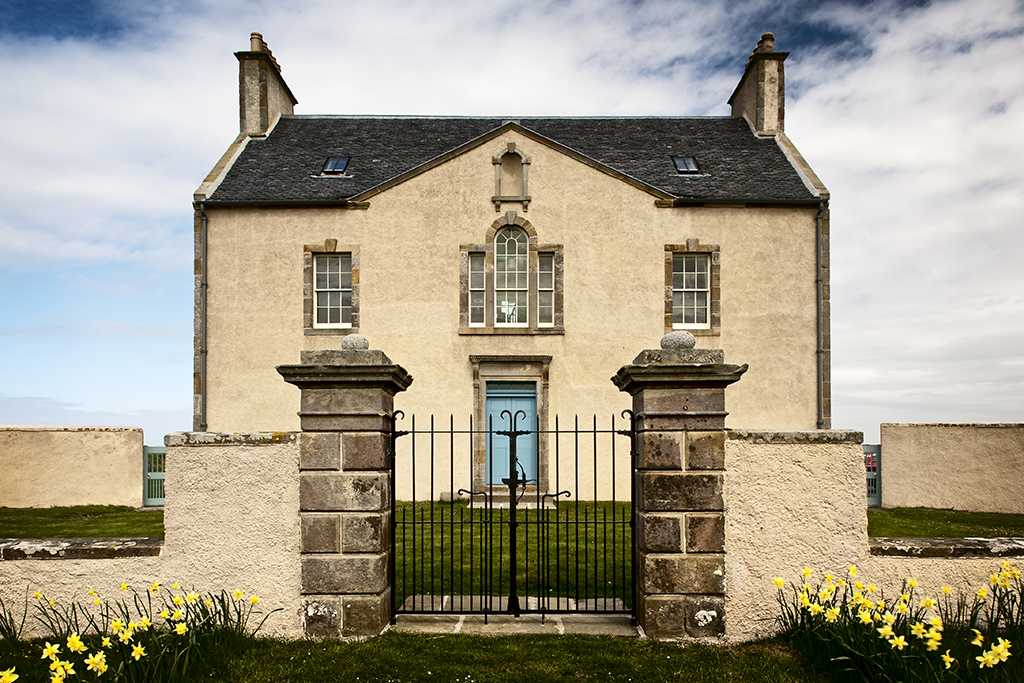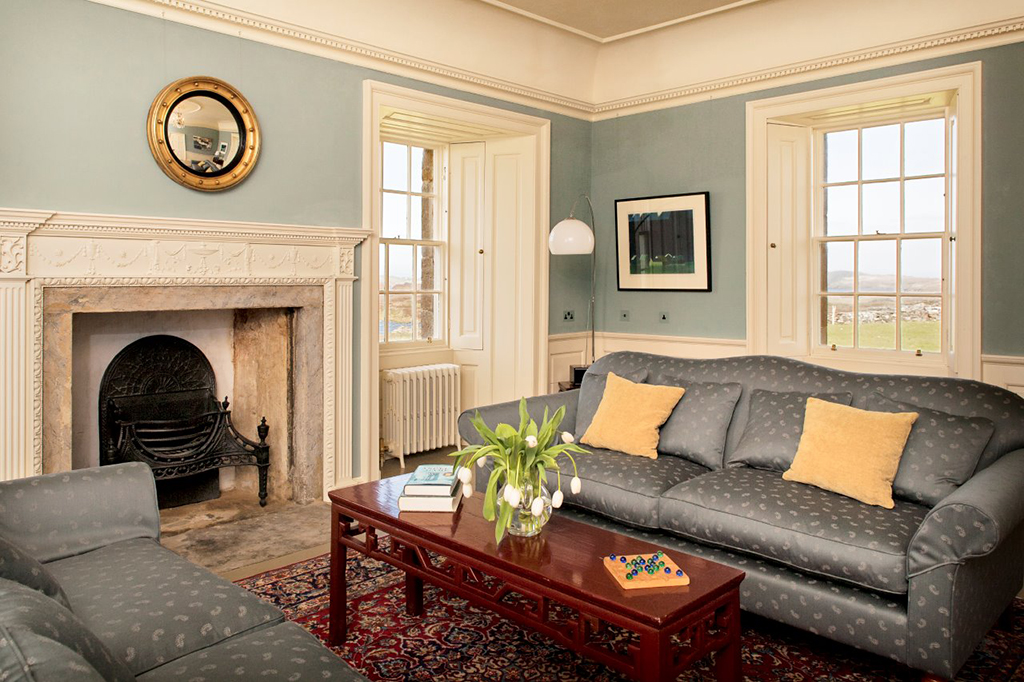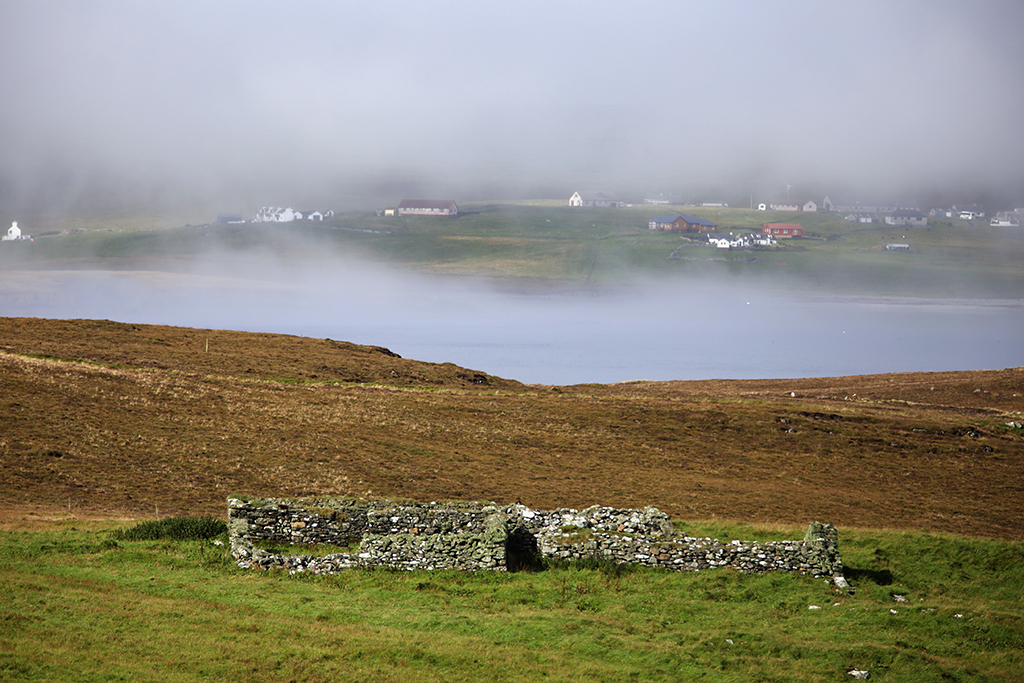Scottish Field travelled to the most northerly inhabited island in Scotland to stay in a restored Georgian mansion.
WHERE IS UNST AND WHY DO I WANT TO GO THERE?
Unst is the most northerly inhabited island in Great Britain. The third largest of the Shetland islands (after Mainland – the main island and Yell), it has 650 inhabitants, is 12 miles by five miles (46 square miles in all), yet packs in a remarkable wealth of history – of both the natural and man-made varieties.
SO HOW DO I GET THERE?
First of all you have to get to the mainland of Shetland, and there are two main ways of doing that. The first is to Lerwick by ferry from Aberdeen (www.northlinkferries.co.uk), a journey of 12 hours which costs from £17 for a foot passenger and £54 for a car. The second is by flying into Sumburgh from Glasgow, Edinburgh or Aberdeen with LoganAir (there are also summer flights from Bergen, Manchester and Inverness-via-Kirkwall). Sadly, the ferry which shuttles between Bergen-Torshavn-Rejkavik ceased stopping at Lerwick a couple of years ago). Prices for flights are variable, but rarely cheap, and Sumburgh you’ll need a hire car to get anywhere from the airport, which is on the southern tip of the island about 45 minutes from the “capital” of Lerwick (don’t rely on buses, which are rubbish; you’d be as well off cycling or hitching).
From Lerwick, the journey is of a variable time given that you need to take two ferries to get to Unst. The first ferry is from Toft (an hour north of Sumburgh, 40 minutes from Lerwick) to Ulsta on the isle of Yell, a crossing of about 20 minutes. You then need to drive across Yell to the ferry at Gutcher, a drive of about 30 minutes, then take the ferry across to Belmont on Unst, a crossing of 10-15 minutes. The cost of both ferries for one person and a car is £14, but that’s effectively a return given that you don’t need to pay on southbound ferries. Ferries run pretty much every hour and during the summer it’s worth ringing 01595 745804 and booking (which is free, and can be done at any time up to half an hour before the ferry departs).
In all, it should take between two and a half to three hours from Sumburgh to Unst,
WHERE TO STAY:

Belmont House on Unst
We stayed at the remarkable Belmont House, a wonderfully restored Georgian house just up the hill from the ferry slip which was built in 1775 by Thomas Mouat of Garth.
It took a trust comprised of concerned locals – including local MSP Tavish Scott’s parents – several years to raise the £1.2m to restore this laird’s house, which is based on a trip to the rather grander Hopetoun House outside Edinburgh. The restoration of this four-bedroomed, three bathroomed by the celebrated Edinburgh architects Grove-Raines was sufficiently impressive that it won a slew of major awards. You can rent it for a minimum of three days (£750 – £900), and there’s also a restored outhouse which used to house staff, and which is good for ensuring your annoying teenagers are out of sight and out of mind. Renting Belmont costs £1,300 per week in the low season and £1,800 in the high season.
There are several other options, including Baltasound Hotel, which is situated on the bay which before the First World War was the busiest herring port in the world, with over 600 boats. There is also a 26-room bunkhouse at Saxa Vord, an RAF base which closed down in 2006, which is in the north of the island.

Comfort at Belmont House
WHAT TO SEE & DO ON UNST:
There are two main options: wildlife and the built-environment, most of which involves the dreaded Vikings (hardly surprising given that the first chunk of land they encountered on the way from Norway was this little island).
The wildlife is spectacular and is one of the main reasons why people come to Unst. The island in general – and the Hermaness National Nature Reserve in particular – is a hotspot for twitchers, with a whole range of bird-watching activities available. At the Keen of Hamar NNR looking for the Shetland Mouse-Ear, a small plant,which is unique to Unst, and dodging the aggressively territorial bonxies (as the great skua is known in Shetland) are highlights.
The wildlife offering extends to far more than just birds though. The increasingly regular visits of two pods of orcas – you can virtually guarantee to see them during August – draws visitors, as does the presence of basking sharks. Our guide, the wonderful Brydon Thomason of Shetland Nature (www.shetlandnature.net), who is from the nearby island of Fetlar but runs wildlife holidays on Unst, took us for an otter watching trip and we were richly rewarded with the sight of a dratsi (Shetland for otter) and her three cubs frolicking and hunting in a remote bay. We watched them for a couple of hours as they caught fish and crabs, and played with a young grey seal who came to investigate.
If Unst’s natural bounty is prodigious, the Norse heritage revealed in its place names means it is also home to more Viking sites per square mile than anywhere else on earth. There are several brochs, longhouses, a full-size longboat and other sites, some of them easily accessible but others reached by well-signposted walks (the whole island is fairly flat and great for walks). We stayed at Belmont House and from there we could access a Viking longhouse and a broch within a 10-15 minute walk.
As well as an intriguing ruined castle at Muness built by Laurence Bruce – a bad boy ruler who impregnated half of the female population – and sacked by pirates in 1627, there are also several other places well worth visiting. The Boat Haven at Haroldswick is a paean to the island’s nautical history, and contains several examples of the typically Shetland sixareen boats in which the island’s intrepid fishermen took to seas. The nearby Heritage Centre is also well worth visiting: it’s relatively small, but has tons of interesting information and exhibits on subjects as diverse as the Clearances of Unst, the construction of the famous Muckle Flugga lighthouse on the island’s north side by Robert Louis Stevenson’s family (the map in Treasure Island is said to be based on that of Unst), and the island’s astonishing and unique geology.

Bobby’s Bus Shelter
Also worth a stop is Bobby’s Bus Shelter near Baltasound, named after a child who saved it from removal. It is equipped with a sofa, books and a television set, and is maintained by locals.
EATING & DRINKING:
The basic idea is to bring your own, although the Baltasound Hotel does do meals, there is a restaurant of variable quality at Saxa Vord, and a travelling Chinese restaurant sets up in the various halls once a month (a sign at the Belmont Ferry will tell you when their next appearance will be). There is also a wonderful little café called Victoria’s Vintage Tea Rooms at Haroldswick, which serves outrageously good home-baking. The island has three shops, and a new pub has just opened up.
There is, however, a fully functioning gin distillery called Shetland Reel at Saxa Vord, which produces five very good gins and gin liqueurs (www.shetlandreel.com). Mark Turnbull, its knowledgeable boss, holds tastings and tours on request, and at £10 they are very good value.
ANYTHING ELSE?
Yep, bring your waterproofs and some boardgames – it can get pretty wet and windy up there!
LOCAL PRODUCE

Morning fog on Unst
The Final Checkout in Baltasound is a small supermarket and café locally owned and managed serving homemade soup, snacks and homebakes. Open Mon to Sat 9am – 6pm & Sun 11am – 6pm. Check for café opening times on (01957) 711666.
Skibhoul Stores & Bakery in Baltasound has a very good reputation for their handmade produce. Café open during summer season serving homemade soups, breads and oatcakes to sit in or fill your flask (01957) 711304.
Henderson’s Stores (known locally as ‘Ethel’s’) stocks Shetland dairy produce and well as local crafts (01957) 711411.
Victoria’s Vintage Tea Rooms (01957 711885) in Haroldswick offers good local food in cosy surroundings.
PLACES TO EAT
Saxa Vord Restaurant, Haroldswick, tel. 01957 711839. Enjoy Shetland’s finest local produce (fish, shellfish, lamb, pork and beef) cooked simply and very well in Britain’s most northerly restaurant. Advanced booking requested – not open until end of May.
Baltasound Hotel, Baltasound, tel. 01957 711334. Selection of dishes available using local produce. Open for lunch and evening meals but please check first.
Final Checkout, Baltasound, tel. 01957 711666. The Final Checkout shop/cafe serves hot snacks and drinks. Homemade soups and homebakes are also available.
TAXI HIRE
Taxi – A Priest, Uyeasound (01957) 755344
Taxi/coach/ self-drive – P&T Coaches (01957) 711666
PUBLIC TRANSPORT
Inter island ferries – the ro-ro car ferry crosses frequently from Yell to Unst for the ten minute passage over Bluemull Sound. We recommend you book your ferries, full details at www.shetland.gov.uk/ferries
Bus Service – services from Lerwick to Unst twice daily Monday to Saturday. Lerwick to Sumburgh (Airport) daily Mon to Sat. No local service on Sundays. See www.zettrans.org.uk/bus/BusTimetables.asp for full details.
Or for an easy to read website to find your next bus or ferry: http://travel.shetland.org/desktop_homepage.php
LOCAL WALKS
Following the coast route north from Belmont House is a gentle walk for sightseeing, wildlife encounters and archaeological sites on the island.
A short walk along the coastline from Belmont House will take you to Belmont Broch. Also up the gentle hillside to an ancient Norse Farmstead.
There are several walking ‘trails’ around Unst with full details in the in-house materials at Belmont.
TAGS

